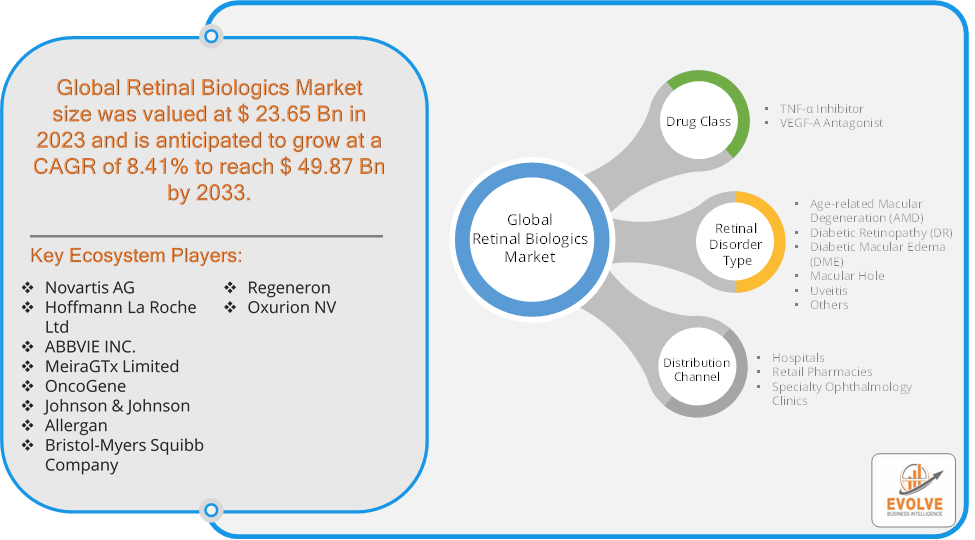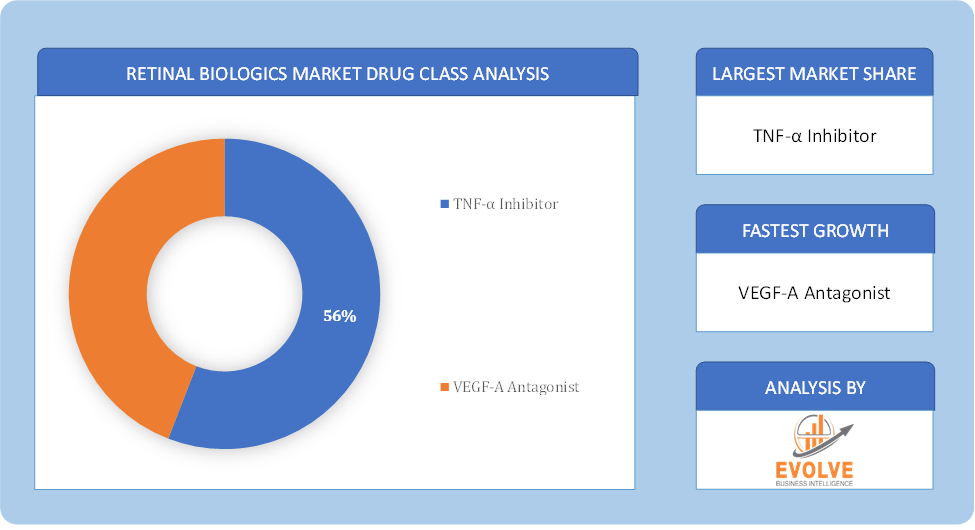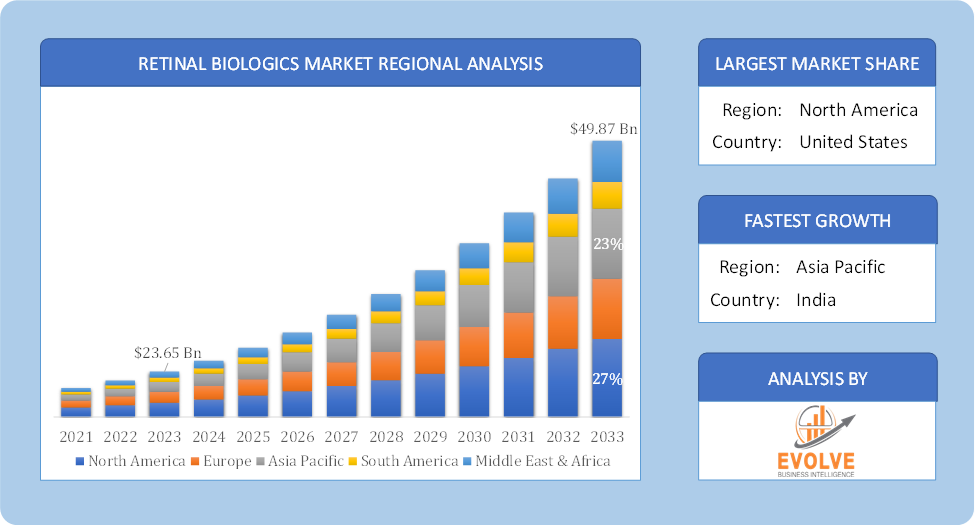Retinal Biologics Market Overview
The Retinal Biologics Market Size is expected to reach USD 49.87 Billion by 2033. The Retinal Biologics industry size accounted for USD 23.65 Billion in 2023 and is expected to expand at a compound annual growth rate (CAGR) of 8.41% from 2023 to 2033. The retinal biologics market focuses on treatments derived from biological sources to address retinal diseases, including age-related macular degeneration (AMD), diabetic retinopathy, and retinal vein occlusion. These biologics, such as anti-VEGF (vascular endothelial growth factor) agents, are designed to inhibit abnormal blood vessel growth and leakage in the retina. The market is driven by the increasing prevalence of retinal disorders, advancements in biologic therapies, and growing investment in ophthalmic research. Key players include pharmaceutical and biotechnology companies developing innovative biologic treatments to improve patient outcomes and preserve vision.
Global Retinal Biologics Market Synopsis
 COVID-19 Impact Analysis
COVID-19 Impact Analysis
The COVID-19 pandemic has led to supply chain disruptions leading to supply shortages or lower demand in the Retinal Biologics market. The travel restrictions and social-distancing measures have resulted in a sharp drop in consumer and business spending and this pattern is to continue for some time. The end-user trend and preferences have changed due to the pandemic and have resulted in manufacturers, developers, and service providers adopting various strategies to stabilize the company.
Global Retinal Biologics Market Dynamics
The major factors that have impacted the growth of Retinal Biologics are as follows:
Drivers:
⮚ Advancements in Biologic Therapies
Technological progress and innovation in biologic therapies have led to the development of highly effective treatments for retinal diseases. Anti-VEGF (vascular endothelial growth factor) agents, for example, have shown remarkable success in managing conditions like AMD by inhibiting abnormal blood vessel growth and leakage.
Restraint:
- Limited Awareness and Diagnosis
In some regions, particularly in developing countries, there is a lack of awareness about retinal diseases and the availability of biologic treatments. Additionally, limited access to advanced diagnostic tools and ophthalmic care can result in underdiagnosis or late diagnosis of retinal conditions, reducing the potential patient pool for biologic therapies.
Opportunity:
⮚ Advancements in Genomic and Personalized Medicine
Emerging research in genomics and personalized medicine offers the potential for developing targeted biologic therapies tailored to individual genetic profiles. This personalized approach can enhance treatment efficacy and reduce side effects, creating opportunities for new biologics that address specific genetic mutations or disease subtypes.
Retinal Biologics Market Segment Overview
 By Drug Class
By Drug Class
Based on the Drug Class, the market is segmented based on TNF-α Inhibitor, VEGF-A Antagonist. VEGF-A Antagonists dominate due to their proven effectiveness in treating a range of retinal disorders, including Age-related Macular Degeneration (AMD) and Diabetic Retinopathy (DR).
By Retinal Disorder Type
Based on the Retinal Disorder Type, the market has been divided into Age-related Macular Degeneration (AMD), Diabetic Retinopathy (DR), Diabetic Macular Edema (DME), Macular Hole, Uveitis, Others. Age-related Macular Degeneration (AMD) dominates due to its high prevalence among the aging population and the significant impact of biologic therapies in managing this condition.
By Distribution Channel
Based on Distribution Channel, the market has been divided into Hospitals, Retail Pharmacies, Specialty Ophthalmology Clinics. hospitals typically dominate as the primary distribution channel due to their comprehensive facilities for administering complex biologic treatments and the high volume of patients requiring advanced retinal care.
Global Retinal Biologics Market Regional Analysis
Based on region, the market has been divided into North America, Europe, Asia-Pacific, the Middle East & Africa, and Latin America. The area of North America is anticipated to dominate the market for the usage of Retinal Biologics, followed by those in Asia-Pacific and Europe.
 Retinal Biologics North America Market
Retinal Biologics North America Market
North America dominates the Retinal Biologics market due to several factors. In 2022, the Retinal Biologics Market in North America held a 45.80% market share. One of the continuing problems for the US and other countries is thought to be eye ailments. America accounted for the largest market because to the rising rates of uveitis, diabetic retinopathy, macular degeneration, and other eye illnesses. Approximately 196 million people worldwide currently suffer from macular degeneration; by 2040, that figure is expected to increase to 288 million. Due to the increasing number of new cases of eye diseases in this area, there is a growing need for retinal biologics products.
Retinal Biologics Asia Pacific Market
The Asia-Pacific region has been witnessing remarkable growth in recent years. From 2023 to 2032, the Asia Pacific retinal biologics market is anticipated to grow at a substantial rate. This region has seen a rise in market growth as a result of increased research into the development of retinal biologics and the rising incidence of eye disorders. Furthermore, the aging population is driving the demand for retinal biologics.
Competitive Landscape
The competitive landscape includes key players (tier 1, tier 2, and local) having a presence across the globe. Companies such as Novartis AG, Hoffmann La Roche Ltd, ABBVIE INC., MeiraGTx Limited, and OncoGene are some of the leading players in the global Retinal Biologics Industry. These players have adopted partnership, acquisition, expansion, and new product development, among others as their key strategies.
Key Market Players:
- Novartis AG
- Hoffmann La Roche Ltd
- ABBVIE INC.
- MeiraGTx Limited
- OncoGene
- Johnson & Johnson
- Allergan
- Bristol-Myers Squibb Company
- Regeneron
- Oxurion NV
Key development:
In September 2022, Johnson & Johnson advanced its retinal biologics portfolio by announcing positive results from clinical trials of its new anti-VEGF treatment, enhancing its position in the retinal disease market.
Scope of the Report
Global Retinal Biologics Market, by Drug Class
- TNF-α Inhibitor
- VEGF-A Antagonist
Global Retinal Biologics Market, by Retinal Disorder Type
- Age-related Macular Degeneration (AMD)
- Diabetic Retinopathy (DR)
- Diabetic Macular Edema (DME)
- Macular Hole
- Uveitis
- Others
Global Retinal Biologics Market, by Distribution Channel
- Hospitals
- Retail Pharmacies
- Specialty Ophthalmology Clinics
Global Retinal Biologics Market, by Region
- North America
- US
- Canada
- Mexico
- Europe
- UK
- Germany
- France
- Italy
- Spain
- Benelux
- Nordic
- Rest of Europe
- Asia Pacific
- China
- Japan
- South Korea
- Indonesia
- Austalia
- Malaysia
- India
- Rest of Asia Pacific
- South America
- Brazil
- Argentina
- Rest of South America
- Middle East & Africa
- Saudi Arabia
- UAE
- Egypt
- South Africa
- Rest of Middle East & Africa
| Parameters | Indicators |
|---|---|
| Market Size | 2033: USD 49.87 Billion |
| CAGR (2023-2033) | 8.41% |
| Base year | 2022 |
| Forecast Period | 2023-2033 |
| Historical Data | 2021 (2017 to 2020 On Demand) |
| Report Coverage | Revenue Forecast, Competitive Landscape, Growth Factors, and Trends |
| Key Segmentations | Drug Class, Retinal Disorder Type, Distribution Channel |
| Geographies Covered | North America, Europe, Asia-Pacific, South America, Middle East, Africa |
| Key Vendors | Novartis AG, Hoffmann La Roche Ltd, ABBVIE INC., MeiraGTx Limited, OncoGene, Johnson & Johnson, Allergan, Bristol-Myers Squibb Company, Regeneron, Oxurion NV. |
| Key Market Opportunities | · Technological advances and new product approvals |
| Key Market Drivers | · Growing number of cases with ophthalmic disorders causing chronic retinal diseases across the globe and increasing prevalence of retinal vein occlusion (RVO) and age-related macular degeneration |
REPORT CONTENT BRIEF:
- High-level analysis of the current and future Retinal Biologics Industry trends and opportunities
- Detailed analysis of current market drivers, restraining factors, and opportunities analysis in the future
- Historical market size for the year 2021, and forecast from 2023 to 2033
- Retinal Biologics market share analysis for each segment
- Competitor analysis with a comprehensive insight into its product segment, financial strength, and strategies adopted.
- Identifies key strategies adopted by the key players including new product development, mergers and acquisitions, joint ventures, collaborations, and partnerships.
- To identify and understand the various factors involved in the global Retinal Biologics market affected by the pandemic
- To provide year-on-year growth from 2022 to 2033
- To provide short-term, long-term, and overall CAGR comparison from 2022 to 2033.
- Provide Total Addressable Market (TAM) for the Global Retinal Biologics Market.


 Retinal Biologics North America Market
Retinal Biologics North America Market


